Italian Guided Missiles Cruisers and Helicopter cruisers (1962)
The first Italian helicopter missile cruisers:
The Andrea Doria class became an important step in the reconstruction of the Italian Navy after WW2, following the modernization of former cruisers, such as the Garibaldi, reconfigured as a Terrier missile cruiser. Italian engineers were given in 1956 the greenlight to develop a brand new cruiser from scratch, adapted to modern warfare. Plans were approved in 1957 and voted under the 1957-58 new construction law. Since top speed, artillery and armour protection were no longer the main focus, the space freed by machinery helped to devise a smaller, yet better distributed hull around two main assets: A Terrier missile system, and helicopters for ASW warfare. One of NATO’s priorities at that time was indeed the threat of the black sea fleet numerous Soviet submarines. These ships formed the backbone of the Italian fleet with Garibaldi until the latter was replaced by Vittorio Veneto in 1970, another helicopter cruiser, but with twice the displacement of the Doria class.
The term “Helicopter cruiser”, like “helicopter destroyer” in cold war nomenclature usually refers, as a convention, to the fact the ship is capable of carrying more helicopters than the usual number (one or two) with extensive facilities. In the Italian case they were both “missile” and “helicopter” cruisers. The term of missile cruiser was abandoned in the 1980s as conventional cruisers were, in principle, all disarmed. An existing cruiser was assumed to be missile-equipped. The helicopter was a considerable asset as its vertical take off/landing capabilities (STOVL) allowed to use a reduced deck surface contrary to an aircraft carrier. Helicopters proved more efficient and versatile for SAR operations as well as reconnaissance and ASW warfare, and could be carried in some numbers, while keeping the ship’s deck surface free and capabilities intact, leading to the creation in all navies of hybrids.
The new names given to these ships were prestigious ones. They referred to the Genoese Renaissance admiral Doria, and Roman consul Gaius Duilius respectively.
Design development history
The two ships that made up this class were initially planned as multi-role vessels, designed to perform in a balanced command and control, anti-aircraft and anti-submarine warfare, defending naval formations. They were designed also with NBC protection in mind, with the possibility of full isolation from the environment and to be able to carry out washing and radioactive de-pollution of the superstructures. After all it was the cold war and a nuclear war was a very real and realistic threat the military trained for.
Displacement and the dimensions were rather limited, in part because of cost issues, and because their role did not required much space. They were characterized by a continuous flush deck, with find entries but rather wide stern. The aft area as characterized by its large flight deck and hangar. Initially a third cruiser of this class was planned, Enrico Dandolo (C 555). Its construction was cancelled, as the Vittorio Veneto (C 550) was ordered instead, 50% heavier, carrying twice as much helicopters. The Dorias, recently entering service in 1964, already showed they were a bit too small. Veneto was ordered in 1965.
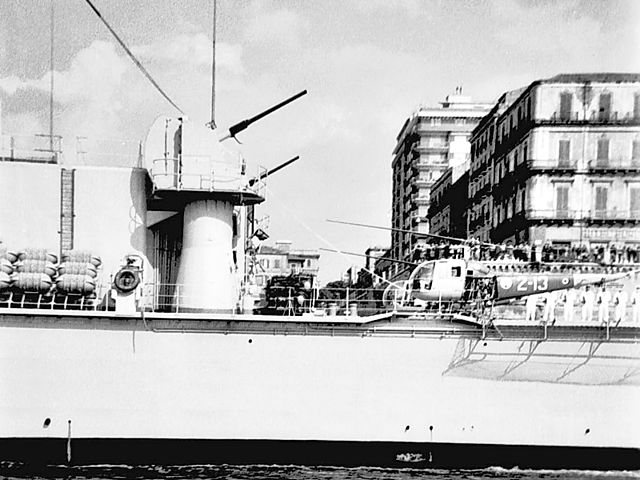
Aft OTO Melara gun, hangar and AB-47 on Duilio’s deck
Design
Powerplant
The propulsion was steam powered with four Foster & Wheleer boilers and two steam turbines connected by two-propeller turbo-reducer groups, with a power of 60,000 HP which allowed a speed of 31 knots with a range of 6,000 miles at 15 knots.
Armament
Missiles:
For medium and long range AA defense, a Mk 10 Mod.10 launch pad for Terrier missiles was located in the forward area. The Terrier was the standard US/NATO naval SAM. It used on the Doria the horizontal loader Mod.10, also able to load the SM-1, Typhoon LR and ASROC in case (this was never done). The loader was fed by four barillets under the main deck, down to the bottom of the ship. It was also adopted by the Veneto, making the Italian Navy the last foreign user of the Terrier, in 2006.
Guns:
The short-range AA defense, eight single 76/62 mm O.T.O. Melara were provided. They were arranged amidships, laterally placed, with four on each side around the main bridge. Only the two abreast the main mast were just above deck level, two forward were on the roof superstructure level, the four aft on the hangar roof. These versatile, reliable, compact and fast weapons proved one of the most stunning Italian cold war industrial successes.
ASW TTs:
The ships were equipped with two triple 324 mm Mk 32 torpedo tube banks. The Mk.32 were standard US/NATO ASW acoustic torpedoes, with a effective firing range of 9600 yards, a 24-minute search duration at 12 knots, fitted with a 107 pounds HBX warhead using a Mk 19 Mods 4/11 contact exploder.
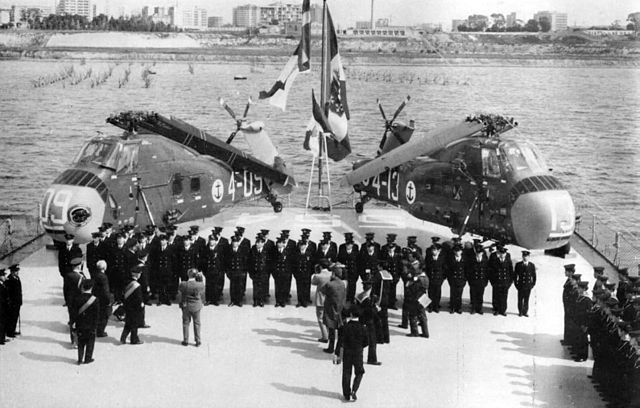
SH-34J on board Andrea Doria during a review
Aviation

Agusta-Bell 204/205 src wingspalette.com
At first it was designed to house four Sea King helicopters, which had a long range and fully amphibious capabilities (landing and taking off from water).
But in service, it proved too cramped and instead, the space available only allowed for accommodating four AB-204 medium helicopters (Agusta-Bell, UH-1 licenced model) or two SH-34 heavy helicopters while the poop below the flight deck was reserved for mooring. The hull was given Denny Brown stabilizing fins for roll reduction.
Sensors
-The Terrier were guided by two Sperry AN/SPG-55A radars allowing for simultaneous guidance of both missiles.
-The OTO Melara AA guns were served by four Argo NA-10 furing direction centers.
-The ASW component consisted of the AN/SQS-23 sonar placed in the foward hull section, locating targets, data passing to the TT command.
The electronic warfare adopted also initially comprised a three-dimensional Frescan AN/SPS-39 air warning and search radar, and the R.C.A. AN/SPS-12. The ship’s main mast also carried the navigation radar S.M.A. MM-SPQ-2 and a TACAN beacon for aviation navigation.
Although it was sufficient to ensure minimal cooperation with NATO’s multinational naval forces both ships were criticized as lacking automated command and control systems. They were implemented during subsequent modernization works.
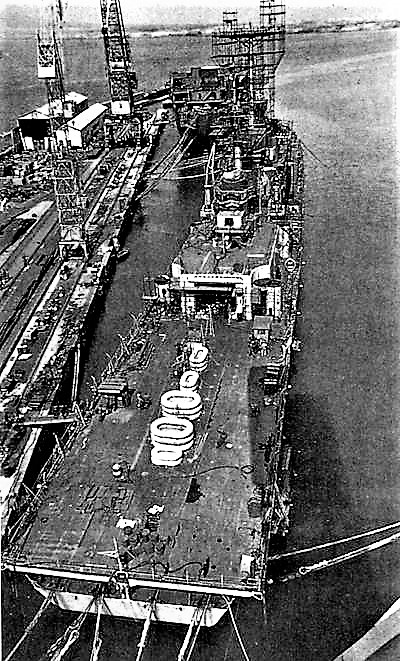
Caio Dulio in Completion in 1963
Doria class (1964) |
|
| Dimensions | 149.3 x 17.3 m x 5 m (490ft x 56ft 5in x 16ft 5in) |
| Displacement | 5,000 tons standard, 6,500 tons FL |
| Crew | 485 |
| Propulsion | 2 shafts geared steam turbines, 4 FW boilers 60,000 hp |
| Speed | 30 knots ( km/h; mph) Range 5000 nm/7 kts |
| Armament | 1×2 Terrier SAM (30), 8× 76mm/62, 2×3 ASW 324mm TTs |
| Sensors | SPS-12, SPS-39A, SPQ-2, Sonar SQS-39 |
| Aviation | 4 Agusta-Bell helicopters |
Doria class early career 1964-72
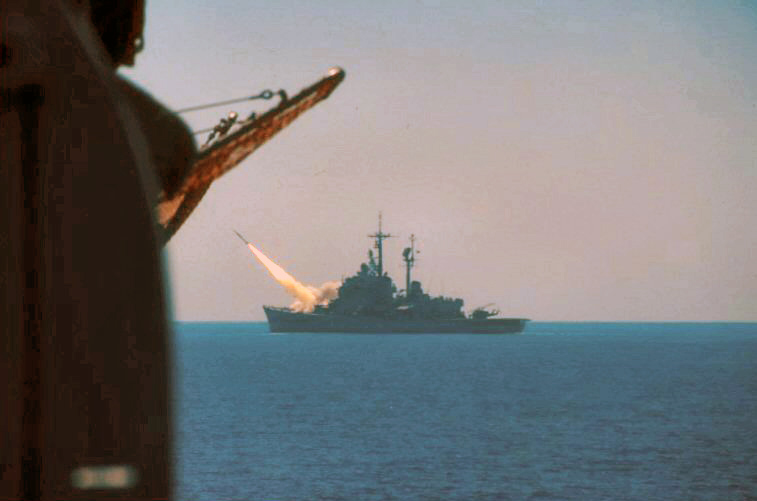
Andrea Doria firing her terrier missile
The Doria and Duilio were built at CNR, Riva Trigoso and Castellammare di Stabia respectively, ordered the same day and laid down at six days interval in May 1958. They were launched in December 1962 (Duilio – so the class could have been named after her) and February 1963, and completed in 1964, February for Doria and November for Duilio.
These represented a leap forward in the future by their general concept, suitable for anti-aircraft and anti-submarine escorts of naval formations, and the the result of a controversial confidence of N.A.T.O. and the USA towards the Italian Government in a difficult phase of the cold war.
Although sufficient to ensure cooperation with NATO multinational forces these ships were soon recognise as being too small and lacking automated command and control systems. They would be modernized later.
Before this, their operational career was intense and eventful. Doria received the combat flag from Admiral Mario Bussola, coming form the previous Battleship Andrea Doria, on 3 August 1964. After her first missile launch, she took to the sea for a training campaign in the Far East, at the occasion of the Tokyo Olympics. She returned from this long cruise on 5 December, after travelling some 22,294 miles under command of her first Captain, Giuseppe Galluccio.
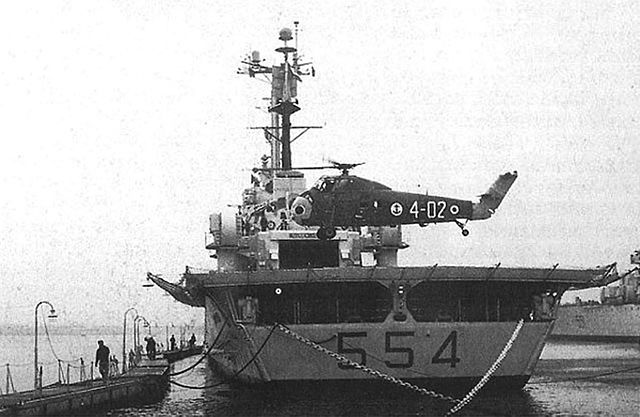
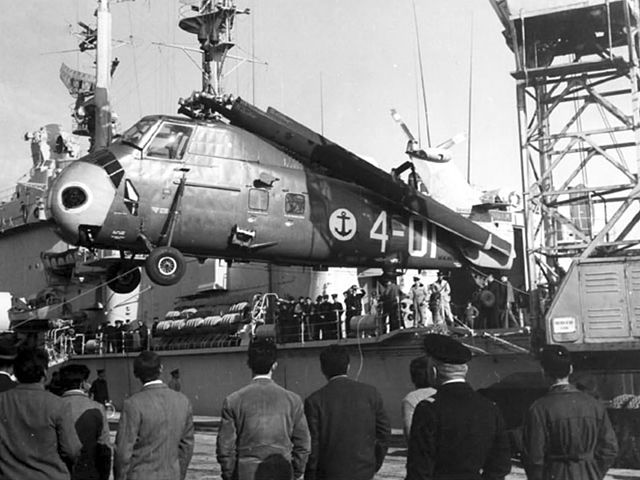
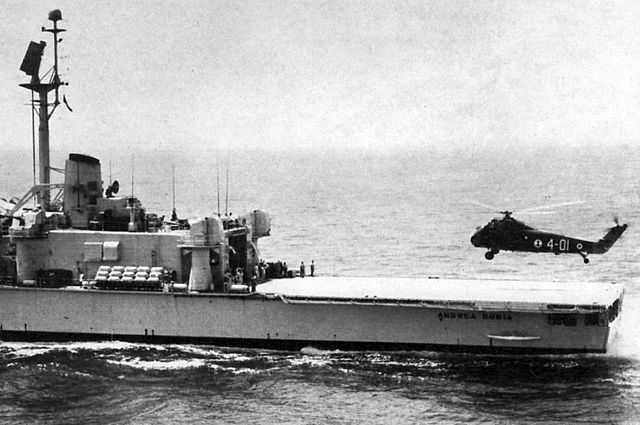
For most of their career, the ships carried the SH-34 helicopter, after the Agusta AB-47 (Bell 47), and before the AB 204/205 and Sea King.
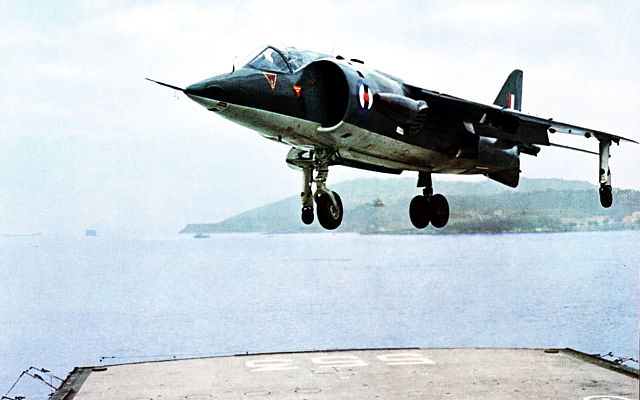
In the 1980s, tests were made of landings and take-offs of the AV8B Harrier deployed on the aircraft carrier Garibaldi.
She made another another cruise of 13,010 miles in South America under command of Captain Claudio Celli. She trained in Taranto on January 19, 1965 in a massive exercize. Considered a prestigious Unit and ambassador of the Italian Navy, she roamed the length and breadth of the Mediterranean, participating in the most complex national and NATO inter-allied exercises. Down Patrol and Quick Draw, Iles d’Or, were among these. In the latter, she was awarded the 1973 “Ship of the Year” prize. During an overhaul in 1976-1978 her powerplant was retired and completely modernized, converted from oil to diesel. The missile system was also modernized and standardized along NATO’s latest setup.
Modernization
During the seventies, the two ships saw the installation of the first automatic systems of the combat operations direction (SADOC 1). This was a first for Italian ships. In the meantime, their electronic suite was also overhauled, with the R.C.A. AN/SPS-12 replaced by the Lockheed Electronics AN/SPS-40 radar, and later by the MM/SPS-768 long-range air-naval discovery radar. It was in fact manufactured in Italy, by Selenia, and became standard for the large units of the fleet. Its installation needed to modify the support bracket of the rotating antenna dish. Added to this, the ship’s original three-dimensional Frescan AN/SPS-39 long range aerial detection radar was replaced by the US-manufactured Hughes AN/SPS-52. Her TACAN tube apparatus was replaced by a modern, solid state system. Diesel and missile system brought to current US standards was also carried out. Instead of three sea kings, the ship was given four AB 212 medium helicopters or down to two SH 3D Sea King heavy helicopters.
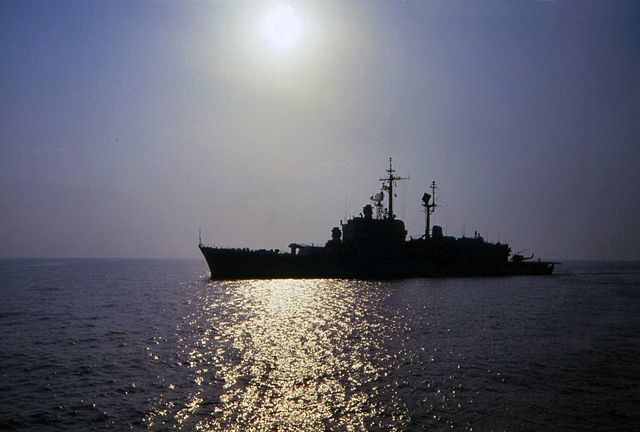
Andrea Doria late in her career
Modernization also implied the addition of two 105 mm SCLAR multiple rocket launchers. They could elevate and pivot, and were able to simultaneously load different types of rockets such as Chaff, flares or smoke, as well as explosive rockets at a radius of 10 km. Rate of fire was one rocket per second. These were mounted along the main deck, roughly halfway along the ship, one on each side, in two semicircular protruding pads. The rest of the armament was left as it was.
Late career 1979-90
In 1979 Doria was deployed in the Far East, with the Vittorio Veneto and Stromboli, for a humanitarian operation in favor of Vietnamese refugees. She was seen in operation in 1980 in the waters of the Tyrrhenian Sea, participating in search and rescue operations (SAR) for an Italian DC-9 crashed at sea near Ustica. On 29 November 1980, she was in Naples, helping populations hit by the earthquake Irpinia.
Transferred from La Spezia to Taranto, she assumed the role of command headquarters for the 2nd Naval Division. She participated in a peace keeping mission off Lebanon in 1984, in support of the Italian land forces, and later part of the Multinational 1986 peacekeeping mission in the Libyan crisis.
On 11 September 1992, she was at sea for the last time, carrying the 2nd Naval Division HQ on board. Upon returning, she was berthed for a disarmament. Her keel had seen 577.00 miles, in all the seas of the world. On 30 September she was at berth no. 23, Torpedo Station in Taranto. A last flag hoisting ceremony was held, chaired by the Commander in Chief of the Ionian Sea and Otranto canal, Admiral Alfeo Battelli. The 30 officers which were in command of Doria also took part. Officially though, she was stricken in 1991, seeing the most part of the cold war.
About Caio Dulio
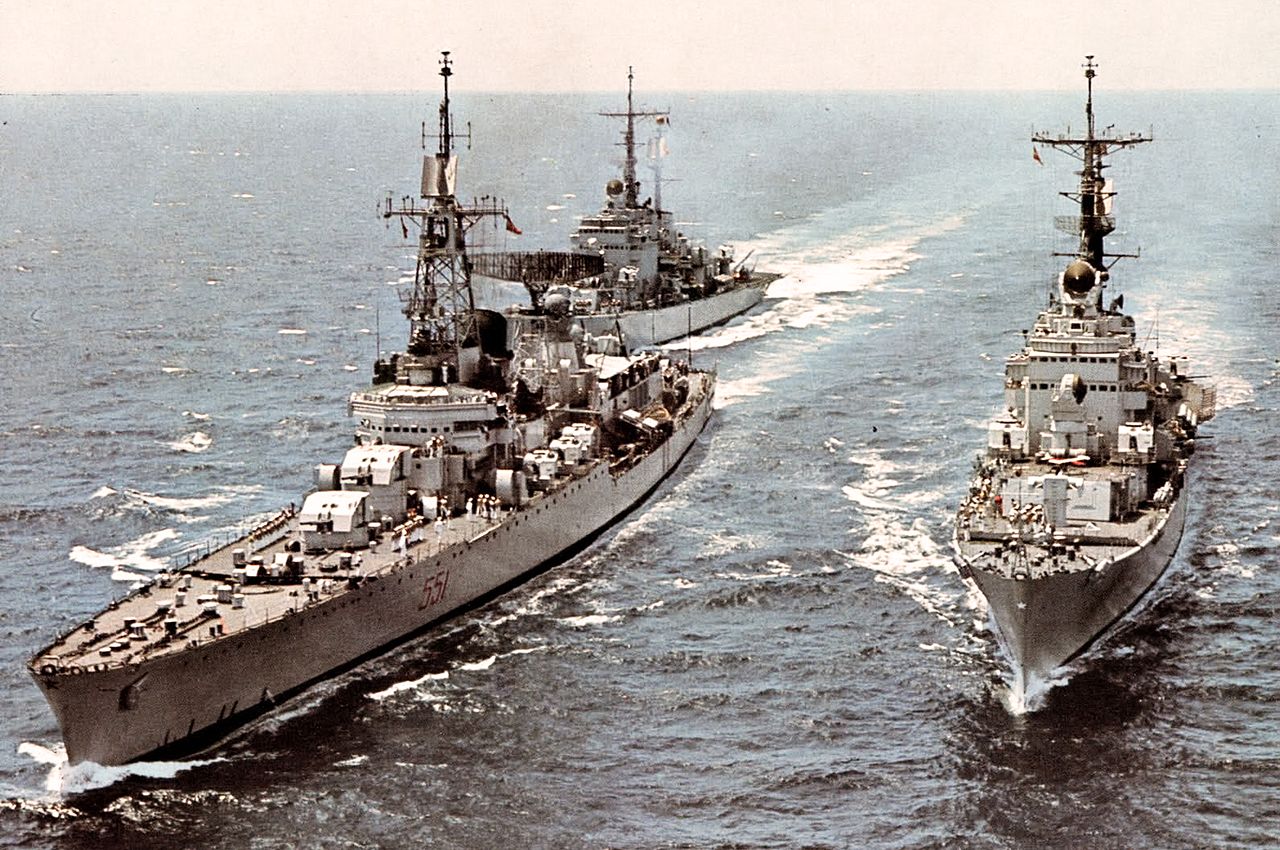
Doria, Duilio and Garibaldi in an epic photo, 1970s
The ship bears a name seemingly associated with the previous Fascist regime, which was fond of using the image of the Roman Empire. How it was so ? The Roman leader Caio Duilio, consul of Rome in 260 BC was indeed the only one honored that way because of its specific connection to the Italian naval history: He was indeed victorious over the powerful Carthaginian fleet, having the idea of building and training crews for a fleet of 120 ships, a first for Rome, a land power until then. He also had the idea of equipping she ships with the “corvus”, the famous assault mobile bridge and exploit the Roman hand-to-hand combat abilities, helping to win the first Punic war. The battle of Milazzo helped the Romans becoming the new masters of the western Mediterranean.
The name Caio Duilio was used on an ironclad, also built in Castellammare di Stabia in 1880. With its 450 mm guns, it was considered the most powerful warship in the Mediterranean. The second was a 1915 dreadnought, was discarded in 1956 after reconstruction in 1937-1940 and ww1 and ww2 service. The last to bear this name is a large frigate of the Orizzonte Class, D 554, built this time by Fincantieri, Riva Trigoso/Muggiano in 2009.
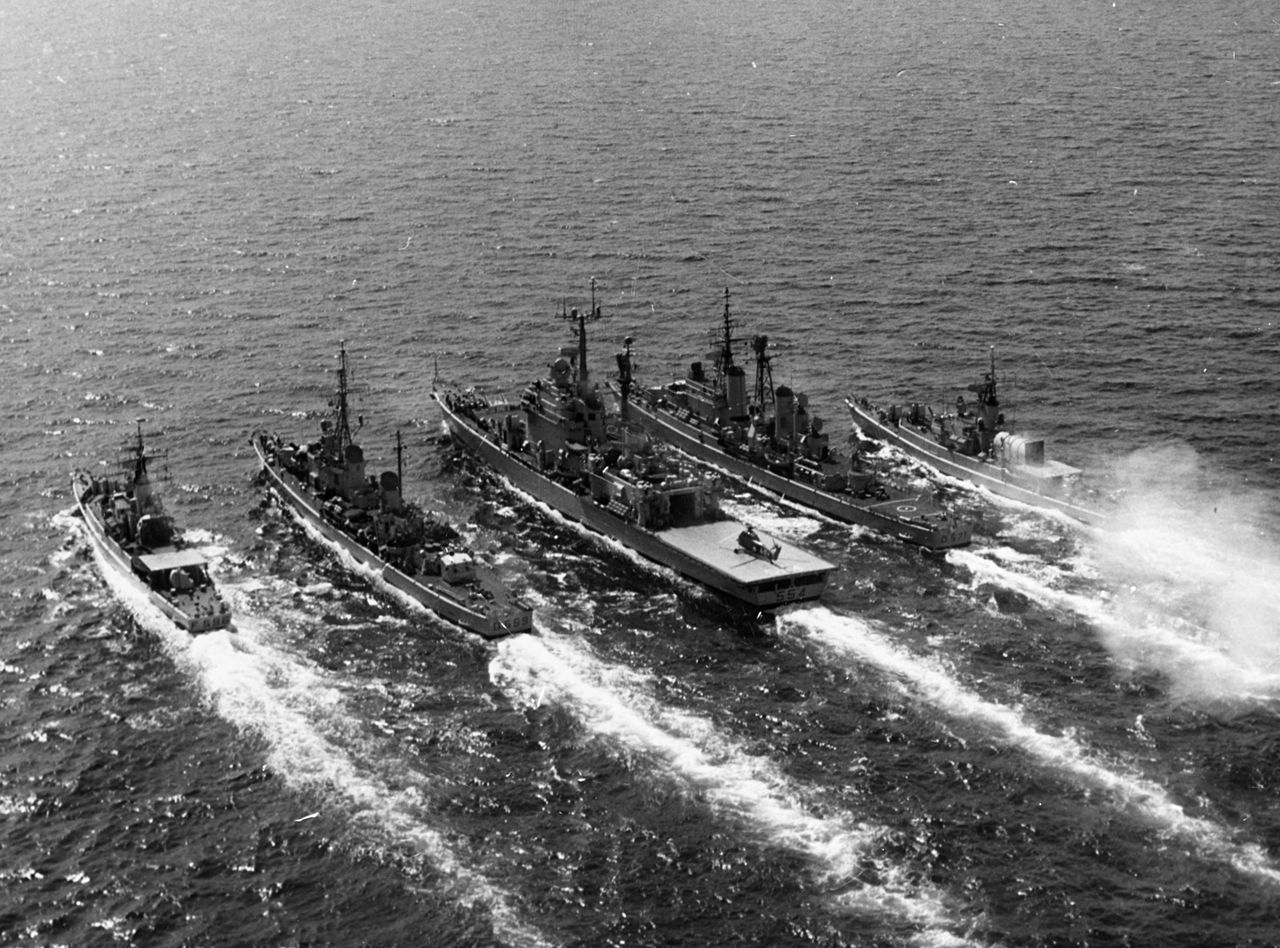
Italian cruiser Caio Duilio underway in the early 1970s with destroyers and frigates
If not lackluster, Duilio’s career was less prestigious than her sister ship: Assigned to the 2nd Offshore Naval Group, 2nd Naval Division, she was based in Taranto in the 1980s, after refit. She was transferred from Taranto to La Spezia while her sister ship Andrea Doria made the reverse trip. After her relocation, Caio Duilio became a training ship for the Naval Academy of Livorno, replacing the old AA cruiser San Giorgio decommissioned in 1980 (a former, rebuilt “Capitani Romani” class ship). She needed to be adapted for this new task, and it was necessary to make changes in her accomodation and decrease her armament, removing two of her 76/62mm guns and reduced AB helicopters to just two. She made numerous training cruises. The 1984 one brought her to the United States and it was held in conjunction with the Los Angeles Olympic Games. Duilio passed for this the panama canal and stopped at many cities along both coasts of the United States. The 1988 cruiser saw her in the Pacific, stopping in Australia in conjunction with the bicentennial of the continent’s discovery. She was decommissioned in 1991.
Both could be compared to the 1960s Moskva-class helicopter carrier and the French cruiser Jeanne d’Arc.
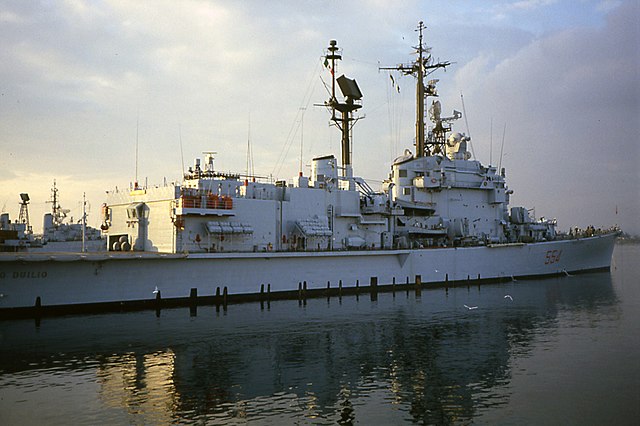
Caio Diulio off Lebanon in 1984
Read More/Src
Books:
J. Gardiner, Conway’s all the world’s fighting ships 1947-95
John Moore, ed. (1981). Jane’s Fighting Ships, 1981-1982. New York: Jane’s Information Group.
https://commons.wikimedia.org/wiki/Category:Caio_Duilio_(554)
https://commons.wikimedia.org/wiki/Category:Andrea_Doria_(553)
https://it.wikipedia.org/wiki/Classe_Andrea_Doria_(incrociatore)

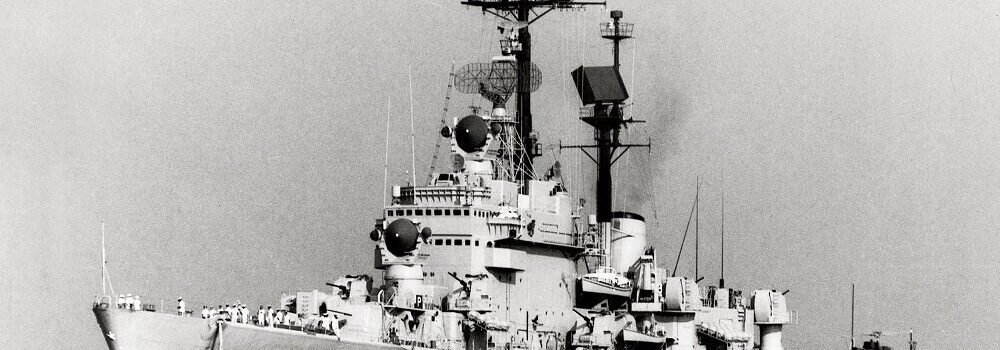

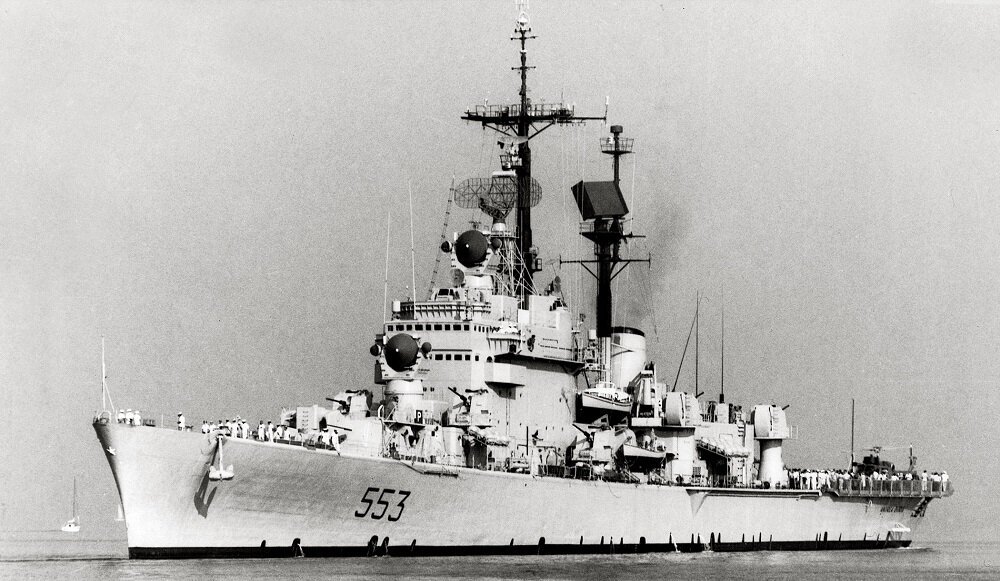
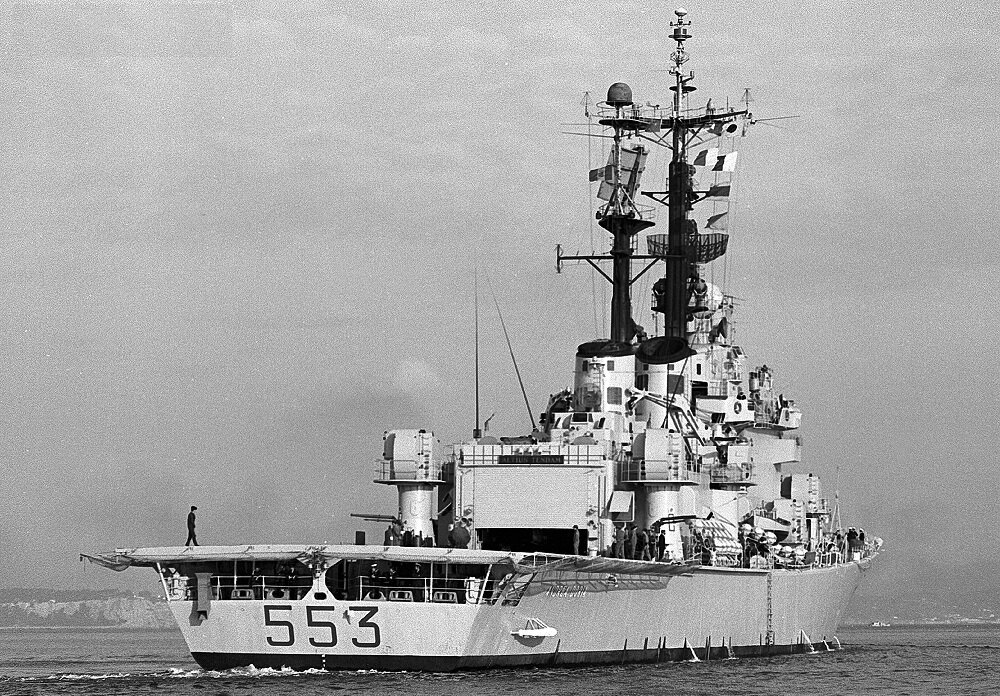
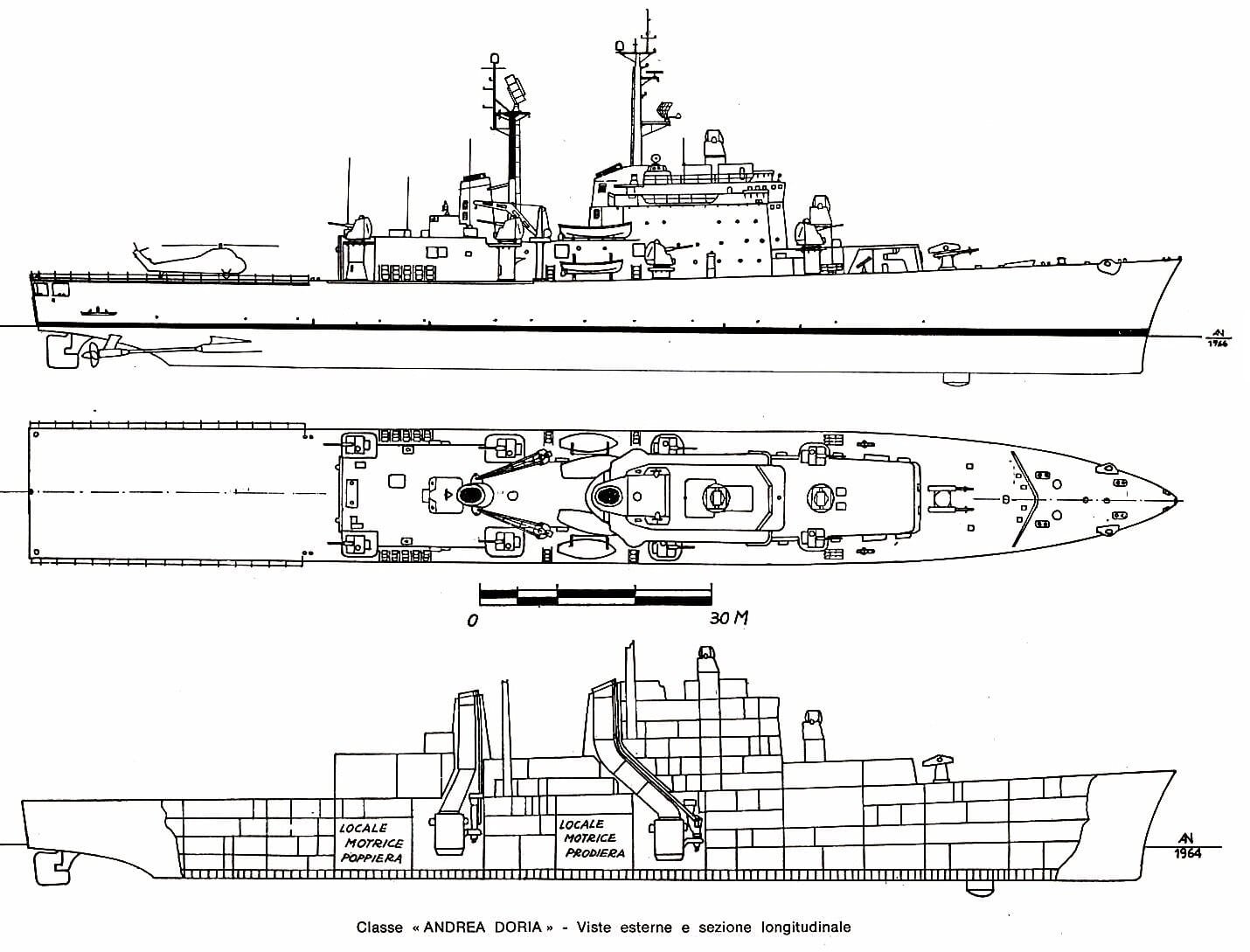
 Latest Facebook Entry -
Latest Facebook Entry -  X(Tweeter) Naval Encyclopedia's deck archive
X(Tweeter) Naval Encyclopedia's deck archive Instagram (@navalencyc)
Instagram (@navalencyc)





 French Navy
French Navy Royal Navy
Royal Navy Russian Navy
Russian Navy Armada Espanola
Armada Espanola Austrian Navy
Austrian Navy K.u.K. Kriegsmarine
K.u.K. Kriegsmarine Dansk Marine
Dansk Marine Nautiko Hellenon
Nautiko Hellenon Koninklije Marine 1870
Koninklije Marine 1870 Marinha do Brasil
Marinha do Brasil Osmanlı Donanması
Osmanlı Donanması Marina Do Peru
Marina Do Peru Marinha do Portugal
Marinha do Portugal Regia Marina 1870
Regia Marina 1870 Nihhon Kaigun 1870
Nihhon Kaigun 1870 Preußische Marine 1870
Preußische Marine 1870 Russkiy Flot 1870
Russkiy Flot 1870 Svenska marinen
Svenska marinen Søværnet
Søværnet Union Navy
Union Navy Confederate Navy
Confederate Navy Armada de Argentina
Armada de Argentina Imperial Chinese Navy
Imperial Chinese Navy Marinha do Portugal
Marinha do Portugal Mexico
Mexico Kaiserliche Marine
Kaiserliche Marine 1898 US Navy
1898 US Navy Sovietskiy Flot
Sovietskiy Flot Royal Canadian Navy
Royal Canadian Navy Royal Australian Navy
Royal Australian Navy RNZN Fleet
RNZN Fleet Chinese Navy 1937
Chinese Navy 1937 Kriegsmarine
Kriegsmarine Chilean Navy
Chilean Navy Danish Navy
Danish Navy Finnish Navy
Finnish Navy Hellenic Navy
Hellenic Navy Polish Navy
Polish Navy Romanian Navy
Romanian Navy Turkish Navy
Turkish Navy Royal Yugoslav Navy
Royal Yugoslav Navy Royal Thai Navy
Royal Thai Navy Minor Navies
Minor Navies Albania
Albania Austria
Austria Belgium
Belgium Columbia
Columbia Costa Rica
Costa Rica Cuba
Cuba Czechoslovakia
Czechoslovakia Dominican Republic
Dominican Republic Haiti
Haiti Hungary
Hungary Honduras
Honduras Estonia
Estonia Iceland
Iceland Eire
Eire Equador
Equador Iran
Iran Iraq
Iraq Latvia
Latvia Liberia
Liberia Lithuania
Lithuania Mandchukuo
Mandchukuo Morocco
Morocco Nicaragua
Nicaragua Persia
Persia San Salvador
San Salvador Sarawak
Sarawak Uruguay
Uruguay Venezuela
Venezuela Zanzibar
Zanzibar Warsaw Pact Navies
Warsaw Pact Navies Bulgaria
Bulgaria Hungary
Hungary

 Bundesmarine
Bundesmarine Dutch Navy
Dutch Navy Hellenic Navy
Hellenic Navy Marina Militare
Marina Militare Yugoslav Navy
Yugoslav Navy Chinese Navy
Chinese Navy Indian Navy
Indian Navy Indonesian Navy
Indonesian Navy JMSDF
JMSDF North Korean Navy
North Korean Navy Pakistani Navy
Pakistani Navy Philippines Navy
Philippines Navy ROKN
ROKN Rep. of Singapore Navy
Rep. of Singapore Navy Taiwanese Navy
Taiwanese Navy IDF Navy
IDF Navy Saudi Navy
Saudi Navy Royal New Zealand Navy
Royal New Zealand Navy Egyptian Navy
Egyptian Navy South African Navy
South African Navy






























 Ukrainian Navy
Ukrainian Navy dbodesign
dbodesign